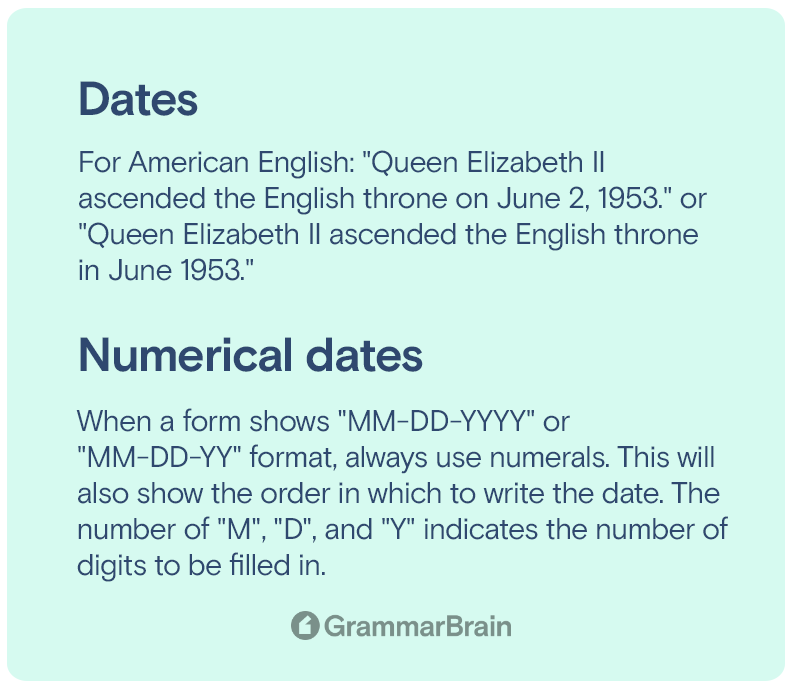Writing dates can seem straightforward at times and confounding at others. This complexity in writing dates arises due to the different formats used worldwide. Many authors also get confused about how to write them using commas. Understanding the established standards and then applying them consistently and clearly are the keys to conquering this difficulty with dates.
Continue reading to learn how to format dates in American English.
Different methods for writing dates
There are several methods for writing dates that are accepted internationally.
Follow dialectical standards
- When using American English, the month should precede the day. First, write the month, then the day, and then the year. Examples are:
- Sep 10
- September 10
- 09/10/2022
- When using American English, separate the day and the year using a comma. If you are including the weekday, place a comma after it as well. A comma is not required if you are using British English. Examples are:
- September 10, 2022
- September tenth, 2022
- Saturday, September 10, 2022
- When using British English, the day should precede the month. This system is followed in many nations, including the UK and Australia. First, write the day, then the month, and then the year. Examples are:
- 10 Sep
- 10th September
- 10 September 2022
- 10/09/2022
- Saturday the 10th of September 2022.
- When using British English, use “of” and “the.” The “of” and “the” should precede the month and day, respectively. It is also crucial to use them both together. Examples are:
- The 10th of September
- Saturday the tenth of September
- When using British English, the day should be followed by ordinal indicators. Use one ordinal indicator like -st, -th, -nd, or -rd that matches the suffix. Though not commonly followed, this format is still accepted in American English. Examples are:
- The 21st of September
- The 14th of September
- The 2nd of September
- The 3rd of September
- When writing for an international audience, use the International Standard to prevent confusion. In this format, first write the year, then the month, and then the day. Commas are not used and all four digits of the year are written. Examples are:
- 2022-09-10
- 2022 September 10
Use different degrees of scope and formality
- When writing extremely formal invitations, be sure to spell the year, month, and day. The day should be written first even when you are using American English. This format is used for official certificates like diplomas and documents with the highest formalities, including wedding invitations. It is used to show deference and courtesy to the occasion and the reader.
Example:
- We request the presence of you and your family on the tenth of September in the year three thousand and thirty.
- When communicating in a semi-formal or slightly formal setting, spell only the month out. It is appropriate to use digits for the year and the day. This format is prevalent in academic writing. There is also a slight variation in the writing style depending on whether you use American or British English.
Example:
- For American English: “Queen Elizabeth II ascended the English throne on June 2, 1953.” or “Queen Elizabeth II ascended the English throne in June 1953.”
- For British English: “Queen Elizabeth II ascended the English throne on 2 June 1953.” or “Queen Elizabeth II ascended the English throne on 2nd of June 1953.”
- Use numerals when writing dates on records and documents. This format is usually followed for memos, impersonal business records like invoices or a piece of communication, or even on lecture notes. This is done to show when the document was made or when it is due. Use all numerals when filling out forms and keeping records. Points to note in this format:
- When writing greeting cards, use the MM/DD/YY format and write the date at the top. This will help the receiver know when the card was written. Example: 09/10/22.
- The YYYY-MM-DD pattern is usually used in museum databases to indicate the date an artifact was obtained. Example: 2022-09-10.
- When filling out government forms, use the MM-DD-YYYY format. Example: 09-10-2022.
Format for numerical dates
- Separate the numerals indicating the day, month, and year using hyphens or slashes. For a more elegant look, bullets or periods can also be used. Underscores are also used in some cases. Always use hyphens when writing in an international format. When using American English, the date September 10, 1992, can be written as:
- 09-10-92
- 09/10/92
- 09.10.92
- 09_10_92
- In international standards, it is written as 1992-10-09
- A writer can optionally add “0” when the day or month is a single-digit number. Although it is frequently necessary on forms, many forgo it in daily informal settings. Using this format will ensure that the numerical dates all have equal lengths and can be accurately sorted. Example:
- June fourth, 2018 can be written as 06/04/18 or 6/4/18. This makes its length similar to that of 12/12/18.
- When a form shows “MM-DD-YYYY” or “MM-DD-YY” format, always use numerals. This will also show the order in which to write the date. The number of “M”, “D”, and “Y” indicates the number of digits to be filled in. Example:
- “MM-DD-YYYY” can be filled in as 09-10-1992 and “MM-DD-YY” as 09-10-92.
Writing centuries
Centuries are written as plurals and when written in words they are written with all lowercase letters. Do not use apostrophes when writing centuries. Examples are:
- Women wore tailored suit dresses in the early 1900s.
- Women wore tailored suit dresses in the nineteen hundreds.
- Women wore tailored suit dresses in the twentieth century.
Writing decades
Apostrophes should be used before and after two-digit numbers used to represent decades, such as the ’90s. You can either write it as the 1990s or simply the nineties. Examples are:
- In the 90s, rock music was very popular.
- In the nineties, rock music was very popular.

FAQs
Should “in” or “on” be used when writing dates?
When referring to an exact day, write the date using “on.” When referring to the year or the month, use “in.”
Example:
I am flying to New York on September 10, 2022.
The cafe will cease operations in September 2022.
How are dates written in technical or official documents?
When writing technical or official documents, always follow international standards rather than American or British English. This will make the document understandable to people belonging to different countries.
Sources:
- Grammarly – How to Write Dates Correctly in English
- Cambridge dictionary – Dates
- The Editor’s Manual – Dates: How to Write Correctly
- LanguageTool – How to Write the Date
Inside this article
Fact checked:
Content is rigorously reviewed by a team of qualified and experienced fact checkers. Fact checkers review articles for factual accuracy, relevance, and timeliness. Learn more.
Core lessons
Glossary
- Abstract Noun
- Accusative Case
- Anecdote
- Antonym
- Active Sentence
- Adverb
- Adjective
- Allegory
- Alliteration
- Adjective Clause
- Adjective Phrase
- Ampersand
- Anastrophe
- Adverbial Clause
- Appositive Phrase
- Clause
- Compound Adjective
- Complex Sentence
- Compound Words
- Compound Predicate
- Common Noun
- Comparative Adjective
- Comparative and Superlative
- Compound Noun
- Compound Subject
- Compound Sentence
- Copular Verb
- Collective Noun
- Colloquialism
- Conciseness
- Consonance
- Conditional
- Concrete Noun
- Conjunction
- Conjugation
- Conditional Sentence
- Comma Splice
- Correlative Conjunction
- Coordinating Conjunction
- Coordinate Adjective
- Cumulative Adjective
- Dative Case
- Determiner
- Declarative Sentence
- Declarative Statement
- Direct Object Pronoun
- Direct Object
- Diction
- Diphthong
- Dangling Modifier
- Demonstrative Pronoun
- Demonstrative Adjective
- Direct Characterization
- Definite Article
- Doublespeak
- False Dilemma Fallacy
- Future Perfect Progressive
- Future Simple
- Future Perfect Continuous
- Future Perfect
- First Conditional
- Irregular Adjective
- Irregular Verb
- Imperative Sentence
- Indefinite Article
- Intransitive Verb
- Introductory Phrase
- Indefinite Pronoun
- Indirect Characterization
- Interrogative Sentence
- Intensive Pronoun
- Inanimate Object
- Indefinite Tense
- Infinitive Phrase
- Interjection
- Intensifier
- Infinitive
- Indicative Mood
- Participle
- Parallelism
- Prepositional Phrase
- Past Simple Tense
- Past Continuous Tense
- Past Perfect Tense
- Past Progressive Tense
- Present Simple Tense
- Present Perfect Tense
- Personal Pronoun
- Personification
- Persuasive Writing
- Parallel Structure
- Phrasal Verb
- Predicate Adjective
- Predicate Nominative
- Phonetic Language
- Plural Noun
- Punctuation
- Punctuation Marks
- Preposition
- Preposition of Place
- Parts of Speech
- Possessive Adjective
- Possessive Determiner
- Possessive Case
- Possessive Noun
- Proper Adjective
- Proper Noun
- Present Participle
- Prefix
- Predicate



